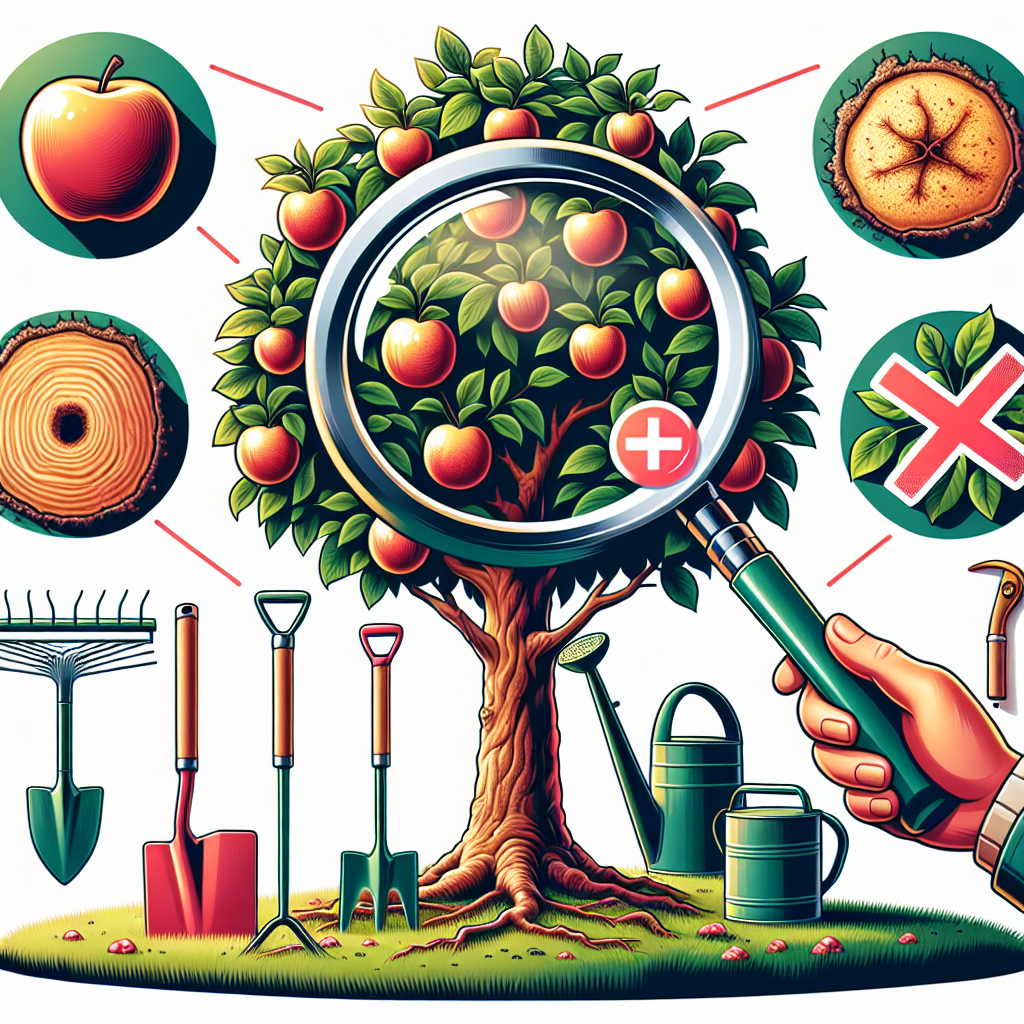Preventing Collar Rot in Fruit Trees
Updated June 26, 2025 at 8:17 am
Discover effective strategies to protect your fruit trees from the damaging effects of collar rot, a common fungal disease, and learn how to maintain the health and vitality of your orchard.

Understanding Collar Rot in Fruit Trees
- Pet Friendly: Fruit trees generally pose little to no harm to pets. Just make sure any treatments used for collar rot are pet-safe.
- Light Requirements: Full sunlight is optimal for the majority of fruit trees, facilitating healthy growth and fruit production.
- Watering: Adequate watering is crucial but be careful not to overwater, as excessive moisture can contribute to collar rot.
- Humidity: Most fruit trees thrive with moderate humidity but it’s important to ensure good air circulation to prevent disease.
- Temperature: While temperature needs vary, consistent environmental conditions help prevent stress which can lead to vulnerability to diseases like collar rot.
- Difficulty: Preventing collar rot requires vigilance and proactive care, making it a moderately challenging aspect of fruit tree cultivation.
There’s something about growing your own fruit that feels incredibly rewarding – that is until you encounter the dreaded collar rot. Collar rot, or Phytophthora crown rot, can put a serious damper on your fruit tree’s health and productivity. It’s a fungal disease that tends to cling to the base of the tree, around the soil line, which can eventually lead to the tree’s downfall.
Identifying Signs of Collar Rot
Before delving into prevention, it’s crucial to know what you’re up against. Collar rot manifests as a dark, water-soaked lesion at the base of the tree. If you peel back the bark, you might find a reddish-brown discoloration of the wood beneath. In some cases, the tree may ooze a gummy substance. Should you notice your trees are suddenly wilting or showing stunted growth or leaf discoloration, it’s time to inspect for collar rot.
Preventive Cultural Practices
The key to preventing collar rot lies in proper planting and site selection. Choose a well-draining location to avoid water buildup around the base of the tree. Also, refrain from planting your trees too deep – the graft union should be well above the soil line. Perhaps introduce raised beds or berms for better drainage, especially in areas with heavy clay soils or poor water runoff.
Choosing Resistant Rootstocks
Did you know that the type of rootstock your fruit tree is grafted onto can affect its susceptibility to diseases? Options such as the ‘Malling-Merton’ series have been bred specifically for their resistance to various soil-borne diseases, including collar rot. It’s definitely worth researching and investing in resistant rootstock, even if the initial cost seems higher. In the long run, they’ll save you heartache and reduce the need for chemical treatments.
Proper Irrigation Techniques
How you water your fruit trees can make a big difference in disease prevention. Make sure to water at the base and avoid wetting the trunk, as this can encourage collar rot. Drip irrigation is a great method, as it delivers water directly to the roots while keeping the trunk dry. Proper mulching can help maintain soil moisture levels without suffocating the base of the tree, just be sure not to pile it up against the trunk itself.
Understanding the Role of Soil Health
A healthy soil ecosystem is your first line of defense against collar rot. Ensuring your soil has plenty of organic matter can help improve drainage and encourage beneficial microorganisms that compete against harmful pathogens. Regularly test your soil to balance its pH and nutrient levels, aiming for slightly acidic conditions which are less favorable to the Phytophthora fungus.
Fungicide Applications: When and How
While cultural practices are at the heart of prevention, sometimes fungicides are necessary, especially if your area is known for collar rot outbreaks. Products such as copper-based fungicides or those containing fosetyl-aluminium can be effective. When applying any fungicide, always follow the label’s instructions and consider the timing – typically in late winter or early spring before bud break, and again in late summer or early fall.
For instance, Agri-Fos Systemic Fungicide is widely recommended for collar rot control. While I haven’t personally used Agri-Fos, I’ve read countless reviews from orchard managers who swear by its efficacy. They talk about how applying it according to the provided instructions has helped their trees recover from early signs of rot and, more importantly, prevented its return.
Find This and More on Amazon
Maintaining a Clean Orchard Floor
A tidy orchard is a healthier orchard. Fallen leaves, fruit, and pruned branches can harbor fungus spores that cause collar rot. Regularly clearing these away can drastically reduce the risk of infection. Additionally, good orchard hygiene involves sanitizing pruning equipment to prevent the spread of disease from one tree to another.
Monitoring for Pests
Pests can cause damage to the bark and introduce the Phytophthora fungus into the wound. Regularly inspecting your trees for signs of insect damage and using appropriate controls, like pheromone traps or insecticidal soaps, can reduce the likelihood of an infection setting in.
Symptoms Management for Infected Trees
If your tree is already showing signs of collar rot, quick action is needed. Trimming away the affected bark and applying a wound dressing can help the tree heal. There’s also the option of surgically removing the infected tissue, a technique known as ‘excising the canker’, but it’s a delicate process best left to professionals.
Biological Control: A Sustainable Alternative
Biocontrol agents, such as Trichoderma species, can be introduced to the soil around the fruit tree. These beneficial fungi compete with Phytophthora for space and nutrients, thereby limiting the pathogen’s ability to grow and infect. It’s a more eco-friendly solution and, when done correctly, can enhance the overall health of your orchard.
Importance of Air Flow and Sun Exposure
Ample air circulation and sunlight play significant roles in keeping collar rot at bay. Make sure to space your trees appropriately when planting, and regularly prune them to maintain open canopies; this will improve air flow and allow sunlight to penetrate, keeping the trunk and soil around it drier.
Stress Management in Fruit Trees
Like us, trees are more prone to disease when they’re stressed. Ensuring your fruit trees are well-nourished, and not competing for resources with weeds or suffering from drought stress, will make them more resilient to diseases like collar rot.
Strategic Fertilization to Enhance Tree Health
Over or under-fertilization can weaken your trees. By following a well-planned fertilization schedule based on soil tests, you’ll promote strong growth and fortify your trees’ defenses. Slow-release fertilizers are often favored as they provide nutrients over time and reduce the chances of run-off that can accumulate at the tree base.
Tree Wraps and Guards: Do They Help?
Using tree wraps or guards around the base of young fruit trees can protect them from mechanical injury and extreme temperature fluctuations, which is often a precursor to disease. However, they should be used with care to avoid creating a moist environment that could harbor fungi.
Planting Alternatives in Collar Rot Prone Areas
If your land is particularly prone to collar rot, diversifying your orchard with some disease-resistant varieties or different types of fruit trees could be a worthwhile strategy. You might be surprised at how shifting the focus to less susceptible varieties can result in a healthier, more productive orchard.
Seeking Expert Advice: When to Consult a Professional
With all the preventive measures in place, sometimes it’s best to seek the advice of a professional arborist or plant pathologist. If you’re facing recurrent issues despite your best efforts, do not hesitate to get an expert opinion.
Relying on Community Wisdom and Experiences
Lastly, your local growers, cooperative extension, or gardening groups can be a wealth of information. They have likely faced collar rot before and can share practical, region-specific advice that has worked for them.
In conclusion, while dealing with collar rot requires a multifaceted approach, focusing on preventive steps can keep your fruit trees healthy and productive. Remember that as with taking care of indoor plants like those thriving in low light conditions, the environment is key in disease management for fruit trees. With careful planning, a watchful eye, and proactive care, you can enjoy a bountiful harvest year after year.
Integrating Companion Planting Strategies
While you might be focused on your prized fruit trees, don’t overlook the potential benefits of companion planting. Certain plants can deter pests or attract beneficial insects, helping to maintain a balanced ecosystem. For instance, marigolds release a substance from their roots that can deter nematodes, which are known to spread collar rot pathogens.
The Role of Quarantine for New Plants
Introducing new trees to your orchard should be done cautiously. Quarantine new trees for a period to observe for any signs of disease before integrating them with your existing plants. This helps in preventing the introduction of Phytophthora and other pests or diseases to your healthy trees.
Emerging Technologies in Disease Detection and Prevention
Advances in agricultural technology have led to early detection systems that can warn growers of high-risk conditions for diseases like collar rot. Sensor technologies, remote imaging, and predictive modeling are all examples of tools you can use to stay one step ahead of potential outbreaks.
Recap of the Collar Rot Battle Plan
To recap, effectively managing collar rot involves a combination of cultural practices, strategic planting, soil health management, and the judicious use of preventive products when necessary. Each of these strategies plays a vital role in creating an environment that discourages the development of Phytophthora.
It’s clear that taking the time to understand and implement effective preventative measures is the best defense against collar rot. Being proactive not just in your immediate actions, but also in planning and design of your orchard, will pay dividends in keeping your fruit trees healthy. Reducing stress on the trees and creating conditions that are unfavorable for the spread of disease can help you avoid the unfortunate situation where you have to deal with an infected tree.
Real-World Success Stories in Combating Collar Rot
In the world of gardening and orchard management, it’s always helpful to learn from the successes of others. Numerous case studies highlight the effectiveness of integrated management strategies, from using resistant rootstocks to incorporating biocontrol agents. Take the time to research and learn from the successes and failures of others, as this can provide you with valuable insights and strategies that are effective in your particular climate and soil conditions.
Regular Orchard Check-Ups: The Key to Early Detection
Just like with your health, prevention is always better than a cure. Regular check-ups can catch the first signs of collar rot before it becomes a major problem. Make it a habit to inspect the base of your fruit trees, looking out for any symptoms or changes that could indicate the early stages of rot. Early detection is vital for effective management and control of this disease.
The Financial Aspect: Weighing Cost vs. Benefit for Disease Prevention
Preventive measures may come with a price tag, but it’s important to weigh these costs against the potential loss of your fruit trees. Implementing raised beds, purchasing resistant rootstocks, or investing in early detection technology may require upfront costs, but consider these as investments into the long-term health and productivity of your orchard.
Collar Rot Prevention Checklist
To keep things straightforward, it’s valuable to have a checklist at hand for collar rot prevention. This summary should include checking for proper drainage, selecting resistant rootstocks, following correct irrigation methods, maintaining soil health, applying fungicides responsibly, keeping the orchard floor clean, monitoring pests, managing tree stress, and opting for strategic fertilization.
Additional Resources for Guidance and Information
Knowledge is power when it comes to preventing collar rot. There are numerous resources available, from extension services to specialized gardening books that provide comprehensive information on disease management. Make use of these resources to strengthen your understanding and inform your approach to maintaining a healthy orchard.
While collar rot can be a challenging disease to tackle, with the right information and tools at your disposal, you can effectively prevent and even recover from outbreaks. Don’t forget to share your own experiences too! You never know – the advice you give might just help someone else save their fruit trees from the destructive clutch of collar rot.
And remember, whether you’re facing challenges in your orchard or indoor garden, always consider the particular needs of your plants. For instance, if you’re looking to grow houseplants that require minimal sunlight, understanding their specific care requirements, such as those detailed for nurturing Philodendron Goeldii, can greatly improve their health and vitality. It’s just like with fruit trees – knowledge of your plant’s needs and preventive measures are key to their success.
.
You are currently writing Content Area 3 of 3, extend from this.
Understanding Local Climate and Its Impact on Collar Rot
Your local climate can significantly influence the risk of collar rot in fruit trees. Areas with long periods of wet weather or high humidity can create environments where the Phytophthora fungus thrives. It’s important to understand the typical weather patterns in your region and how they may contribute to disease risk.
Adjusting your care practices to local conditions is a must. For those in wetter climates, improving soil drainage and increasing plant spacing can help mitigate the risks. Meanwhile, orchardists in drier areas might focus on maintaining consistent moisture levels without over-irrigating—a practice that may inadvertently invite collar rot.
Potential Non-Chemical Alternatives and Natural Solutions
While fungicides can be a part of the solution, there are natural alternatives worth exploring. Compost teas and other natural amendments have been reported to improve soil health and, potentially, help in suppression of the Phytophthora fungus. It’s about creating a robust soil environment where beneficial organisms outcompete the harmful ones.
It’s said that people say incorporating compost and other organic matter regularly can lead to a notable reduction in collar rot problems. The emphasis here is on sustainable orchard management practices that align with maintaining the natural balance of your orchard ecosystem.
Annual Review: Updating Your Approach to Collar Rot Prevention
As with anything in agriculture or gardening, it’s important to continually learn and evolve your practices. An annual review of your collar rot prevention tactics can help you identify what’s working and where there’s room for improvement. Stay informed about the latest research findings and adapt your methods accordingly.
Reflect on the past season and consider any incidence of disease. Were there specific conditions that contributed to the problem? Could your cultivation practices be fine-tuned? Use this information to protect your orchard in the future seasons.
Creating an Integrated Pest and Disease Management Plan
An integrated approach to managing pests and diseases in your orchard is essential. Collar rot doesn’t exist in isolation; it’s part of a complex web of biological and environmental factors. By developing a broader pest and disease management plan, you can tackle collar rot within the wider context of orchard health.
Such a plan might include a combination of cultural practices, biological controls, chemical applications when necessary, and an understanding of the ecosystem services provided by your local environment. Keeping detailed records can also help in identifying patterns and making better-informed decisions.
Engaging with Online Forums and Social Communities for Support
No one has all the answers, but together we can come close. Engaging in online forums or social media communities dedicated to fruit tree cultivation can provide access to a collective wealth of knowledge and experience. From novice gardeners to seasoned experts, members often share valuable insights and ideas that can aid in your fight against collar rot.
Take advantage of these communities to ask questions, share your experiences, and get support from those who understand the challenges you’re facing. It’s a way of staying connected and updated with practical, real-life solutions.
Documenting Your Journey: A Log of Collar Rot Prevention and Treatment
Keeping a garden journal or logbook can be an incredibly useful tool. Documenting your observations, the measures you’ve taken, and the outcomes can help you pinpoint what practices are most effective in preventing collar rot. Plus, this record becomes an invaluable resource for future reference or for helping other orchardists.
Include notes on weather patterns, irrigation schedules, fungicide applications, and any signs of disease. Over time, this journal can reveal trends and provide insights that might not be immediately apparent.
Final Thoughts on Staying Vigilant Against Collar Rot
In the end, the fight against collar rot in fruit trees is ongoing. But don’t let this challenge deter you from the incredible benefits of orchard-keeping. By staying educated, proactive, and vigilant, you can greatly reduce the risks and enjoy the fruits of your labor—quite literally.
Remember, good orchard health isn’t just about fighting diseases; it’s about creating a holistic environment where your trees can flourish. Just like nurturing houseplants in specific conditions requires attention and care, such as providing the right environment for the fostering of ferns in low light, so does managing an orchard. Effort and knowledge go hand in hand to yield the best results—as rewarding as they are delicious.
Shop more on Amazon
Flowers & Plants Team
Flowers & Plants Team



